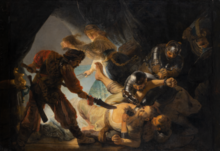
Back الرسم الهولندي في العصر الذهبي Arabic Pintura del Sieglu d'oru neerlandés AST Holland rəssamlığının qızıl dövrü Azerbaijani Нидерландски Златен век в изобразителното изкуство Bulgarian Slikarstvo u Zlatnom dobu Nizozemske BS Pintura barroca als Països Baixos Catalan Zlatý věk nizozemského malířství Czech Ζωγραφική της ολλανδικής Χρυσής Εποχής Greek Nederlanda pentrarta orepoko Esperanto Pintura del Siglo de oro neerlandés Spanish

Dutch Golden Age painting is the painting of the Dutch Golden Age, a period in Dutch history roughly spanning the 17th century,[1] during and after the later part of the Eighty Years' War (1568–1648) for Dutch independence.
The new Dutch Republic was the most prosperous nation in Europe and led European trade, science, and art. The northern Netherlandish provinces that made up the new state had traditionally been less important artistic centres than cities in Flanders in the south. The upheavals and large-scale transfers of population of the war, and the sharp break with the old monarchist and Catholic cultural traditions, meant that Dutch art had to reinvent itself almost entirely, a task in which it was very largely successful. The painting of religious subjects declined very sharply, but a large new market for all kinds of secular subjects grew up.
Although Dutch painting of the Golden Age is included in the general European period of Baroque painting, and often shows many of its characteristics, most lacks the idealization and love of splendour typical of much Baroque work, including that of neighbouring Flanders. Most work, including that for which the period is best known, reflects the traditions of detailed realism inherited from Early Netherlandish painting.


A distinctive feature of the period is the proliferation of distinct genres of paintings,[2] with the majority of artists producing the bulk of their work within one of these. The full development of this specialization is seen from the late 1620s, and the period from then until the French invasion of 1672 is the core of Golden Age painting. Artists would spend most of their careers painting only portraits, genre scenes, landscapes, seascapes and ships, or still lifes, and often a particular sub-type within these categories. Many of these types of subjects were new in Western painting, and the way the Dutch painted them in this period was decisive for their future development.
- ^ In general histories 1702 is sometimes taken as the end of the Golden Age, a date which works reasonably well for painting. Slive, who avoids the term (see p. 296), divides his book into two parts: 1600–1675 (294 pages) and 1675–1800 (32 pages).
- ^ Confusingly, one particular genre of painting is called genre painting, the painting of some kind of everyday scenes with unidentified people. But, for example, still-life is also a genre in painting.